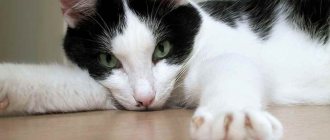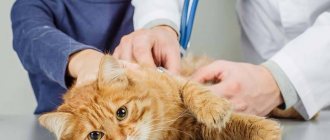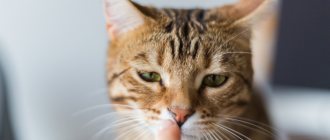Doctors are increasingly faced with the phenomenon of dehydration in cats. Since two-thirds of a cat’s body consists of water, its lack leads to irreversible consequences for the body. If the amount of fluid entering the body is 10% less than the required amount, it is possible to save the animal, but when this amount reaches 20%, dehydration leads to death. Why dehydration occurs and how to treat it is described in this article.
Causes
The cause of a lack of water can be pathologies occurring simultaneously in the body. Coping with the disease is possible only after successful procedures to restore water balance. Dehydration is usually caused by situations that accompany various diseases:
- change in temperature (during the occurrence of concomitant pathologies);
- vomiting, diarrhea (with gastrointestinal upset);
- excessive loss of fluid during urination and bowel movements (with kidney disease or diabetes);
- The lack of a container of water in a cat’s home becomes one of the main causes of dehydration in cats;
- staying outside for a long time in hot weather and getting heatstroke;
- inability to leave a closed, stuffy room for a long time;
- a situation in which the animal was severely injured and profuse hemorrhage occurred;
- feverish condition;
- being in a state of shock or stress during a long move, or acute pain during recent surgery.
What should I do if my cat is dehydrated?
Dehydration in cats is often a sign of a serious illness. If you suspect your cat is dehydrated, contact your veterinarian immediately.
In the meantime, you can try some home remedies to rehydrate your cat:
- Add some chicken broth or tuna juice to the water.
- Instead of dry food, try giving them wet food.
- Place ice cubes in a bowl of water.
You should know your cat's food and water preferences. For example, some cats like to drink water from a water bowl, and some like to use a cat fountain. You should try to encourage them to drink. However, you should never force them.
How is the disease diagnosed?
If the epithelium is excessively dry, a cat is often diagnosed with dehydration. This can be detected by pulling the animal by the withers. In a healthy individual, it should immediately return to its place. If disease is present, the tubercle remains motionless for some time.
At home, you can perform the following test: open the animal’s mouth slightly and lightly press on the gums behind the upper teeth. If they have acquired a light shade, it persists for more than three seconds without immediately returning to its original state - this indicates illness. Probably, the capillaries fill very slowly because the cat is suffering from exicosis.
In a clinical setting, blood is taken for general and biochemical analysis. Additionally, the animal is examined for the presence of diabetes mellitus and kidney and liver pathologies.
Symptoms of dehydration (tests)
Standard dehydration test.
Home tests for skin elasticity and capillary refill time .
The elasticity of the skin is checked by pulling the skin at the nape of the neck. Normally, the skin should immediately return to its original position. A sick animal remains in a drawn-out state for some time. The time it takes for the skin to settle back to its original position indicates the severity of dehydration.
Capillary refill rate
The rate of capillary refill is determined by retracting the upper lip and pressing on the gum. Using a stopwatch, you can measure the time it takes for the area of pressure to lose its whitish mark and return to its original appearance.
Normally, the return process takes up to two seconds. This test is performed to determine blood circulation, the presence of heart failure or shock.
Veterinarian examination
A biochemical blood test can tell you a lot about your cat's health.
In addition to home tests, you should take your cat to a doctor. The clinic will host the following events:
- taking anamnesis;
- visual inspection;
- general blood analysis;
- blood biochemistry;
- Analysis of urine;
- kidney examination;
- liver function test;
- screening for diabetes.
The most significant tests are hematocrit and blood protein levels.
With an increased hematocrit and the presence of protein in the body, almost one hundred percent dehydration is established.
Symptoms
The disease in an animal occurs with symptoms that can accompany various diseases, so it is necessary to show the pet to a doctor.
If an animal suffers from vomiting and diarrhea and does not drink water at all, this is an alarming sign.
The inability to defecate indicates insufficient fluid levels in the body.
If the oral mucosa is light in color, the saliva is viscous and does not excrete well, this indicates the presence of pathologies.
With existing infectious diseases and inflammation, the temperature can not only rise, but also fall. A sharp change in body temperature leads to profuse sweating and, accordingly, loss of large amounts of fluid.
So, let's name the main symptoms of the disease:
- dry skin;
- lethargy of the animal;
- sunken eyes;
- lack of normal appetite;
- constipation or diarrhea;
- arrhythmia;
- body temperature atypical for an individual;
- saliva viscosity;
- light shade of gums.
Causes and consequences of dehydration in cats
About two-thirds of a cat's body consists of water. If the body is dehydrated by more than 20%, it leads to death within a few hours. Kittens are especially sensitive to water imbalance. For them, 10% dehydration is enough to pose a serious threat to life.
An imbalance in the water balance in a pet’s body develops as a result of various factors:
- viral infections - panleukopenia ("feline distemper"), calcivirus infection, herpes and many other diseases occur against the background of severe dehydration;
- In case of poisoning and diseases of the gastrointestinal tract, vomiting and diarrhea are often observed. These symptoms also lead to dehydration, loss of important minerals from the body, and weight loss;
- chronic diseases. Excessive urination if you have diabetes or kidney failure may well lead to the development of a serious metabolic disorder;
- overheating in hot weather under the influence of direct sunlight leads to a lethargic state in the animal. If your cat is so overheated in the heat that it is unable to drink on its own, immediately call a veterinarian;
- intoxication with signs of poisoning. The reasons may be different: the cat inhaled toxins, was poisoned by household chemicals, or ate expired food;
- a stressful state as a result of nervous shock. Cats, like people, can become depressed. Moving or bringing a new pet into the home can lead to the development of pathology;
- consequences of surgery. The postoperative period is characterized by weakened immunity and the likelihood of side effects, one of which may be dehydration;
- blood loss. If the cat has been in a fight or is suffering from blood loss for another reason, it requires urgent hospitalization.
Treatment
If signs of dehydration are noticed, you should immediately begin procedures to restore water balance.
When the above symptoms (not vomiting) are detected, you can try to forcefully inject the cat with water or an aqueous solution with salt and granulated sugar into the oral cavity.
If vomiting, you can inject a solution of sodium chloride or glucose (10 ml) into the cat’s withers. Additionally, you can administer 1 ml of Gamavit. When purchasing livestock, it is better to learn how to give injections from a veterinarian in advance.
Such manipulations will save the cat from loss of moisture and minerals, and help his body before contacting a doctor. Loss of beneficial components can lead to death, while treatment of the concomitant disease can be done later.
At the clinic, cats are treated through intravenous infusions. The cat is brought into the treatment room and fluid is replenished through droppers with a solution that ensures normal vital functions. If it is not possible to regularly attend procedures with a cat, it is left under the supervision of a specialist in a hospital, where treatment procedures are performed.
Emergency care and follow-up treatment
Of course, the best thing is to urgently take the animal to the doctor, carry out the necessary tests and find out the root cause of dehydration, but what to do if the pet’s condition is urgent, how to properly provide assistance?
We move the animal to a cool, dark place and offer a drink. If the animal drinks on its own, we observe that it is quite possible that the absorbed water will not be enough to compensate for the losses and dehydration will progress. Even if the animal does not want to drink, try to stimulate the cat to act, moisten the nozzle, let it lick the water from your fingers, pour a little liquid into the mouth from a syringe without a needle, add special flavors to the drinking bowl.
Treatment of the disease involves the introduction of fluid from the outside. Pull back the skin on the animal's withers and inject a saline solution with glucose. Inject the solution slowly so that it has time to dissolve, thoroughly rub the injection site after removing the needle. Even if the animal feels better, it is recommended to visit a veterinarian for diagnosis; the doctor will tell you how to treat the animal and restore the full value of the water balance. In case of severe dehydration, fluid infusion is performed intravenously - droppers are placed.
Preventive measures
To prevent exicosis, you need to follow simple rules:
- keep a bowl of your favorite liquid within walking distance of the animal;
- if there is more than one cat living in the house, it is better to provide each of them with individual dishes;
- when treating any disease, monitor the cat, monitor its appetite and thirst;
- Along with dry food, give your cat wet food;
- monitor the time the animal spends in direct sunlight;
- If you are urinating frequently, have your pet examined by a doctor.
Some individuals prefer to drink running water. You can install a special drinking fountain for them.
To prevent a sensitive cat from touching the bowl with its whiskers, it should be low and spacious.
Recommendations for owners of special cats
If the furry pet of the family:
- she eats dry food, but for some reason drinks little; her diet should be diversified with wet spiders;
- periodically suffers from dehydration due to improper functioning of the kidneys, subcutaneous injections of medicinal solutions will help, which are performed regularly, at a certain interval and only after a doctor’s prescription;
- a light drinker by nature (there are such people!), this can be considered the norm if the pet is active and eats well, has healthy mucous membranes and elastic skin, regularly goes to the toilet, while the urine is a healthy, light yellow color, and intestinal excrement is normal , soft consistency.
Video - How much water does a cat need?
Forecast
If you become dehydrated, it is important to take action quickly. When all fluid restoration procedures have been completed, the cat's chances of quickly curing the disease that led to dehydration increase.
If the cause of dehydration is a simple lack of fluid intake, the animal quickly recovers after receiving injections and replenishing moisture in the cells and connective tissues. The speed of recovery depends on the age of the cat, the presence of chronic diseases and the state of immunity.
Every owner needs to know how to treat dehydration in a cat, including at home. This will allow her to live without worries and please others for a long time.
How long do cats with kidney failure live?
If we are talking about acute renal failure, then with proper treatment, the animal will return to a full life. Although, since the pathology of renal failure is not eliminated, the cat will always require careful care - diet, periodic visits to the veterinarian. If the disease has reached the terminal stage of chronic renal failure, then, unfortunately, treatment will no longer help. It is unknown how long the pet will live at this stage. It depends on his age, the condition of other organs, and care. In the most severe manifestations of the terminal stage, the animal is euthanized, since chronic renal failure is accompanied by excruciating pain.
An animal with chronic renal failure can fade away in a matter of days
How to spot dehydration
Typically, the level of dehydration is determined by a veterinarian based on a survey of the owner, a general examination of the animal and its tests. The most common way to determine dehydration in animals is a skin turgor test. If the skin on the cat’s withers, pulled upward, slowly returns to its original state, then this is a sign of dehydration, which is measured as a percentage based on the nature of the turgor. This percentage indicates the amount of fluid in the body that the cat lacks. The maximum amount of dehydration that a living animal can have is 15%. Any dehydration of a greater percentage is incompatible with life.
Dehydration 5%.
Pets that are 5 percent dehydrated have little loss of skin elasticity. The skin will return to its normal position, but it will do so a little slower than usual.
With dehydration 6-9%
there is a noticeable delay in the skin returning to its normal appearance. The gums may also be dry and the eyeballs may appear slightly sunken.
In pets with 10-12% dehydration
When pulled back, the skin will remain in a “tent” position. The eyes are significantly sunken, the heart rate increases, and a weak pulse is observed.
Cats with 12-15% dehydration
are in a life-threatening situation. A patient with this type of dehydration is unable to stand and may be in shock. If intensive treatment is not carried out in time, the animal may die.
Normal water content in a cat's body
60% of a healthy cat's body is water!
Three types of dehydration
There are three types of dehydration:
- weak - up to five percent;
- moderate - about five or ten;
- heavy - from ten and more.
Weak dehydration
is practically asymptomatic. A slight weakness of the animal looks like simple fatigue after active games or hunting. Therefore, the onset of dehydration is almost impossible to notice.
Sticky saliva indicates moderate dehydration.
During moderate flow
the most striking and characteristic sign is the stickiness of saliva.
In severe cases
The cat is weak, constantly lies down, does not make contact, and refuses food and water. The doctor should determine the reasons. Finding out on your own will only delay time and aggravate the existing disease.










